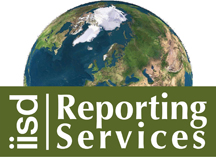News * Abou us * the ENB team * DONATE * Activities * Search * IISD RS home * IISD.org * RSS * What is RSS? * Links |
|
MEA Bulletin Guest Article
Friday,
19 October 2007 MANAGEMENT OF TRANSBOUNDARY WATERS: ASSESSING THE STATUS OF TRANSBOUNDARY RIVERS, LAKES AND GROUNDWATERS By Francesca Bernardini, Rainer Enderlein and Ella Behlyarova, United Nations Economic Commission for Europe Many rivers criss-cross the border between two or more countries, transboundary lakes are shared between two or three countries, and transboundary aquifers underlie two or even three countries. The sustainable management of such shared resources requires knowledge about the current status of water bodies, pressures in the basins that cause transboundary impact, and predictions about water resources development. For transboundary waters, such information is usually not readily available as it is dispersed over many institutions. Moreover, in many countries in transition, information has been gathered in a piecemeal way, as resources for measurements were limited, monitoring stations ceased to function, and an integrated approach to surface water and groundwater management was still in its infancy. A concerted effort of UNECE Governments as well as international organizations and national agencies, involving more than 150 experts, has made a difference. On the occasion of the sixth Ministerial Conference “Environment for Europe” (Belgrade, Republic of Serbia, 10–12 October 2007), the first ever in-depth assessment of transboundary rivers, lakes and groundwaters in the UNECE region has been published. This assessment was drawn up under the leadership of Finland, within the framework of the Convention on the Protection and Use of Transboundary Watercourses and International Lakes (Water Convention, http://www.unece.org/env/water). Entitled “Our waters: joining hands across borders ‑ first assessment of transboundary rivers, lakes and groundwaters,” it covers all major surface water bodies in the European and Asian parts of the UNECE region and transboundary aquifers located in South-Eastern Europe, Caucasus and Central Asia. This assessment, supported by the Finnish Environment Institute, the British Geological Survey, the Slovak Hydrometeorological Institute, the German Federal Ministry for the Environment, the UNECE secretariat, UNEP/GRID-Europe, UNESCO, the World Water Assessment Programme of the United Nations and OSCE, highlights the achievements of over 10 years’ work under the Water Convention to prevent, control and reduce transboundary impact. It serves as a point of reference for measures by Governments, international river basin organizations (joint bodies), other international organizations and relevant non-governmental organizations to improve the status of transboundary waters and agree on joint measures related to integrated water resources management. The assessment also underlines the challenges that countries face in implementing further measures to counteract still existing pressures and improve the ecological and chemical status of transboundary waters. The assessment of transboundary surface waters describes the hydrological regime of 140 transboundary rivers (most of them with a basin area over 1,000 km2) and 30 transboundary lakes, which all were considered by riparian countries as “major” water bodies, mostly due to their importance for water supply and the maintenance of ecological functions. It analyzes pressure factors in the basins, the status of the water bodies (e.g. ambient water-quality data, water-quality classifications), transboundary impact as well as trends, future developments and management measures envisaged. The assessment also examines monitoring systems for transboundary rivers and lakes and provides pressure-related responses and shows that good governance can make a difference in jointly managing transboundary waters. The assessment of transboundary aquifers is structured similarly to the surface waters’ assessment. The characteristics of 70 transboundary aquifers, their uses and functions, groundwater abstraction and use, problems related to groundwater quantity and quality, and the evidence for transboundary effects have been dealt with. The groundwater assessment also provides information on pressure-related response measures. In the present assessment, the impact of human activities on the chemical status has been dealt with more comprehensively than hydromorphological alterations by human activities and their impact on the status of watercourses. Moreover, water-quality problems have been analyzed more deeply than water-quantity problems. Future assessments will address this shortcoming. The assessment has focused on the most critical problems in the region and has revealed that:
In further developing response measures to address these issues, special attention should be given to countries in Eastern Europe, Caucasus and Central Asia as well as South Eastern Europe as these countries face the biggest challenge to reduce transboundary impact. The Meeting of the Parties to the Water Convention will provide guidance in developing and implementing such response measures. This first Assessment is the first step in a long-term process. Future assessments will provide periodic reviews, continuously updated and designed to give an authoritative picture of the state of the transboundary water resources in the UNECE region, as well as provide the basis for continuous bilateral and multilateral cooperation under the Water Convention. The second Assessment is scheduled for production in five years, and preparations will have to start very soon to allow enough time for data collection and synthesis. |

